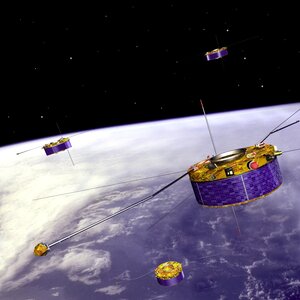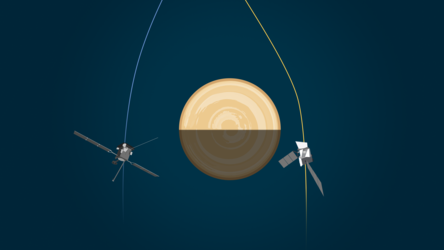I
Igneous rock
Rock that has crystallised from a molten state (magma).
Illuminated (back/front)
Describes a type of electromagnetic wave detector. In solid-state detectors such as CCD silicon chips, the electrodes are all laid on one face of the chip. The incoming X-rays, for example, can enter the silicon detector either on the electrode (front-illuminated) side or the rear (back-illuminated) surface of the detector.
Image
(1) Figure formed by rays of light or other electromagnetic radiation at a mirror's focal plane.
(2) A picture obtained by a telescope, camera, or other imaging device.
Imager
A device for producing an image.
Imaging
Making an image.
Impact crater
See Crater
Inclination angle
The angle between the rotation axis of a planet and the perpendicular to the ecliptic plane.
Inflationary Universe
A model of the early evolution of the Universe involving its exponential expansion. This hypothetical phase in the evolution of the early Universe has been introduced to account for the observed isotropy of the Universe on a large scale and the fact that its density is within a factor of ten of the critical density. In the most popular version of the theory, the exponential expansion is associated with a phase change which occurred about 10-34 seconds after the beginning of the Big Bang. According to grand unified theories of elementary particles, the strong force decoupled from the electroweak force (a force which unifies the electromagnetic and weak nuclear forces) at this time. This event released enormous energy, stored until then in the vacuum of space-time. This scenario can account for the present vast extent of the Universe and its uniformity.
Infrared light
Infrared radiation (or infrared light) is invisible to the human eye, but can be sensed as 'heat', or thermal radiation. Even cold objects emit infrared radiation. It has a wavelength between 7000 Angstroms (less than a micron) and several hundred microns. (See also Electromagnetic radiation.) Only a small fraction of the infrared light coming from astronomical objects can go through the Earth's atmosphere: to detect the full range of infrared wavelengths a space telescope is needed. Cold and dusty astronomical objects – such as planets, asteroids or star forming regions – are best observed with infrared telescopes. ESA's Infrared Space Observatory (ISO), operating at wavelengths from 2.5 to 240 microns, could observe objects that remain hidden for optical telescopes. The next ESA infrared space telescope, Herschel, will peer even deeper into these objects.
Injection (into orbit)
The placing of a satellite into its required orbit or trajectory.
Instrument
Apparatus capable of registering information with a precise objective. A science spacecraft can carry several instruments such as cameras, spectrographs, magnetometers, gas analysers, etc.
Integration (satellite, instrument)
Construction phase for a satellite, instrument or piece of equipment, when its constituent parts are assembled.
Interferometer
Measurement device in which a beam of electromagnetic radiation is split and subsequently recombined after travelling different pathlengths so that the beams interfere and produce an interference pattern. This pattern can be used to measure a wide variety of physical parameters.
Interferometry
Experimental technique making use of an interferometer to measure a physical parameter.
Interplanetary voyage
The journey of a spacecraft through the planets of the Solar System.
Interstellar
Between celestial objects; often refers to matter in space that is not a star, such as clouds of dust and gas.
Ion
An electrically charged atom. It has either lost or gained one or more electrons.
Isotope
A chemical element is characterised by the number of protons in its atomic nucleus. Isotopes are atoms of the same element, i.e. with the same number of protons, but with different numbers of neutrons. Isotopes have the same atomic number but differ in their mass number.
Isotropy
Having the same value of some physical property (e.g., density) when measured in any direction.















 Germany
Germany
 Austria
Austria
 Belgium
Belgium
 Denmark
Denmark
 Spain
Spain
 Estonia
Estonia
 Finland
Finland
 France
France
 Greece
Greece
 Hungary
Hungary
 Ireland
Ireland
 Italy
Italy
 Luxembourg
Luxembourg
 Norway
Norway
 The Netherlands
The Netherlands
 Poland
Poland
 Portugal
Portugal
 Czechia
Czechia
 Romania
Romania
 United Kingdom
United Kingdom
 Slovenia
Slovenia
 Sweden
Sweden
 Switzerland
Switzerland










































